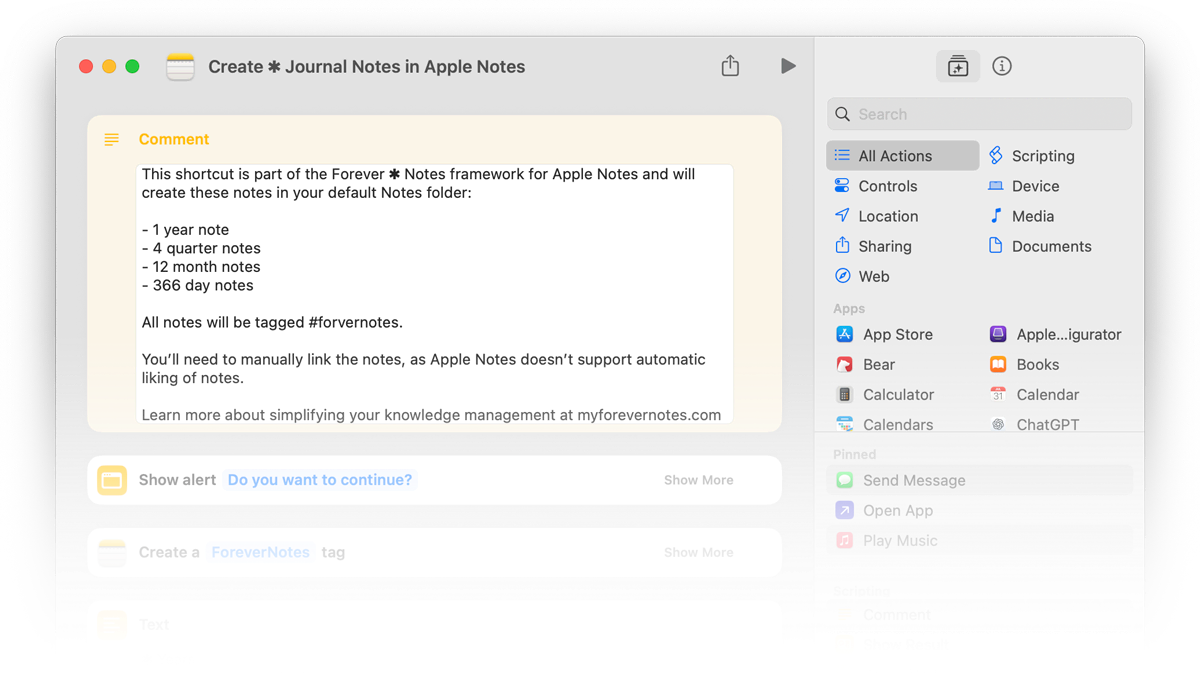How to Use the Forever ✱ Notes Journal in Your Own Language (Step-by-Step Guide)

Want to use the ✱ Journal in German, Portuguese, Spanish, or any other language? You can — and it’s easier than you think. All it takes is a few small adjustments to make the "Create ✱ Journal Notes in Apple Notes" Shortcut work beautifully in your own system language and date format.
This guide will walk you through everything you need to customize — and explain one important step many people miss: making sure your “Open Today’s Note” shortcut uses the same settings as the journal notes you created.
Special thanks to Emerson Veras Filho, a thoughtful and generous community member, who created the first fully translated Portuguese (Brazil) version of the shortcut and inspired this guide. 🎉 Obrigado, Emerson!
But first…
How to Edit a Shortcut
Before you start translating, you’ll need to open the shortcut in edit mode:
- On iPhone or iPad: Open the Shortcuts app → tap the three dots ••• on the shortcut tile
- On Mac: Right-click (or Control-click) the shortcut name in the sidebar → choose Edit
Now you’ll see all the steps inside the shortcut — and you can begin customizing.
What You Need to Change in the “Create ✱ Journal Notes” Shortcut
When you run the Journal Shortcut, it creates 366 daily notes, 12 monthly notes, 4 quarterly notes, and 1 yearly note. By default, everything is in English — but the shortcut is built in a way that you can easily adapt it.
Here’s what you need to localize:
1. All the Text Blocks
Every block in the shortcut that uses manually typed text should be translated. These include:
- “✱ Home”
- “✱ Years”
- “Back”, “Next”, “Today”
- “Q1”, “Q2”, etc.
- Abbreviated month names inside quarter notes (e.g. Jan | Feb | Mar)
If you want your notes to feel natural in your language, go through each of these and translate them into what works best for you.
2. The Dictionary (Month Setup)
There’s a dictionary section in the shortcut that defines how daily note titles are created. Each entry pairs a month (like ✱ January) with a list of days (01, 02, 03, …). You’ll need to:
- Translate the month names into your language
- Leave the list of days unchanged
For example:
- Change ✱ January to ✱ Januar (German), or ✱ Janeiro (Portuguese)
Once you do this, the shortcut will create notes like 9 Januar or 9 de setembro, depending on how you’ve formatted it.
Optional: Change How the Note Titles Are Created
If you want the note title to match your system’s full date format (e.g., 9 de setembro in Portuguese), you can change the note title generation like this:
- Use the “Format Date” action in the shortcut
- Set it to the format you want (e.g. “Long” or “Medium”)
- Set the language or region (e.g. Portuguese - Brazil)
Once you do that, the journal notes will be created with system-formatted titles.
This is a personal choice: some people prefer clean, short titles like “9 September,” others prefer fully formatted ones like “9 de setembro.” Either works — just make sure you stay consistent.
Make Sure Your “Open Today’s Note” Shortcut Matches
Here’s where many people run into trouble: they create their journal notes in one format, but their “Open Today’s Note” shortcut looks for a different format — so the note never opens.
The solution is simple: your Open shortcut must format the date in exactly the same way as your journal notes are titled.
So if your journal notes were created using:
- Format Date: Long
- Language: Portuguese (Brazil)
Then your Open shortcut also needs to:
- Use Format Date: Long
- Set Language to Portuguese (Brazil)
Then your Open shortcut must format the date in the same way:
- Format Date: Custom
- Use the format dd MMMM, dd 'de' MMMM
- Use dd in any case, otherwise the shortcut will have issues with single digit days
If the note title is even slightly different — for example, 9 September vs 9 de setembro — the Open shortcut won’t find the right note.
If you’ve created your own localized version of the shortcut feel free to share it with the community. Just send me a message with the shortcut links and I'll add it to the Resources page.
Let’s keep making Forever ✱ Notes even more universal, together.
If this resonates with you, sign up for the Forever ✱ Notes Newsletter — simple, practical tips on mindful note-taking, straight to your inbox.
